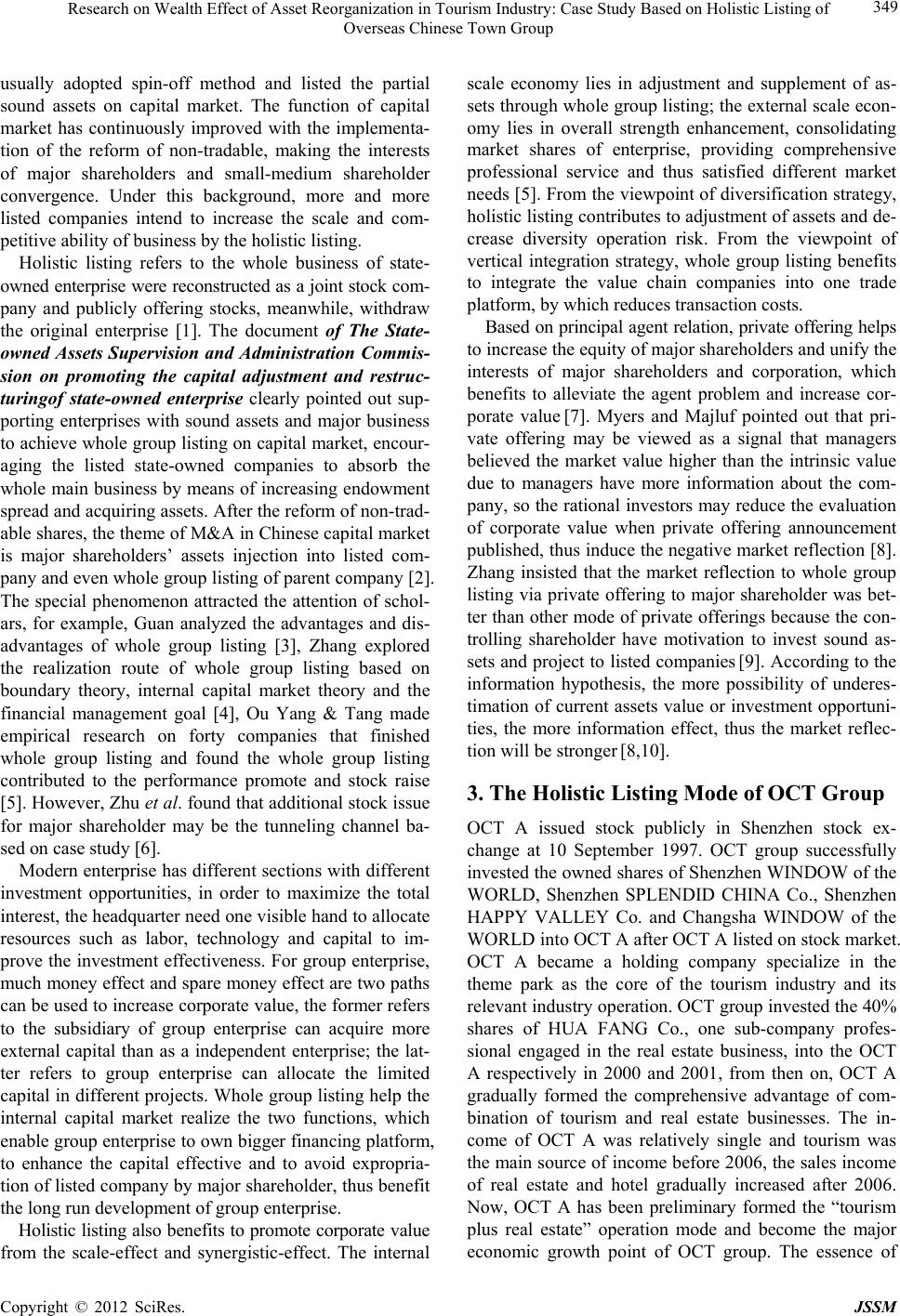
Research on Wealth Effect of Asset Reorganization in Tourism Industry: Case Study Based on Holistic Listing of
Overseas Chinese Town Group
349
usually adopted spin-off method and listed the partial
sound assets on capital market. The function of capital
market has continuously improved with the implementa-
tion of the reform of non-tradable, making the interests
of major shareholders and small-medium shareholder
convergence. Under this background, more and more
listed companies intend to increase the scale and com-
petitive ability of business by the holistic listing.
Holistic listing refers to the whole business of state-
owned enterprise were reconstructed as a joint stock com-
pany and publicly offering stocks, meanwhile, withdraw
the original enterprise [1]. The document of The State-
owned Assets Supervision and Administration Commis-
sion on promoting the capital adjustment and restruc-
turingof state-owned enterprise clearly pointed out sup-
porting enterprises with sound assets and major business
to achieve whole group listing on capital market, encour-
aging the listed state-owned companies to absorb the
whole main business by means of increasing endowment
spread and acquiring assets. After the reform of non-trad-
able shares, the theme of M&A in Chinese capital market
is major shareholders’ assets injection into listed com-
pany and even whole group listing of parent company [2].
The special phenomenon attracted the attention of schol-
ars, for example, Guan analyzed the advantages and dis-
advantages of whole group listing [3], Zhang explored
the realization route of whole group listing based on
boundary theory, internal capital market theory and the
financial management goal [4], Ou Yang & Tang made
empirical research on forty companies that finished
whole group listing and found the whole group listing
contributed to the performance promote and stock raise
[5]. However, Zhu et al. found that additional stock issue
for major shareholder may be the tunneling channel ba-
sed on case study [6].
Modern enterprise has different sections with different
investment opportunities, in order to maximize the total
interest, the headquarter need one visible hand to allocate
resources such as labor, technology and capital to im-
prove the investment effectiveness. For group enterprise,
much money effect and spare money effect are two paths
can be used to increase corporate value, the former refers
to the subsidiary of group enterprise can acquire more
external capital than as a independent enterprise; the lat-
ter refers to group enterprise can allocate the limited
capital in different projects. Whole group listing help the
internal capital market realize the two functions, which
enable group enterprise to own bigger financing platform,
to enhance the capital effective and to avoid expropria-
tion of listed company by major shareholder, thus benefit
the long run development of group enterprise.
Holistic listing also benefits to promote corporate value
from the scale-effect and synergistic-effect. The internal
scale economy lies in adjustment and supplement of as-
sets through whole group listing; the external scale econ-
omy lies in overall strength enhancement, consolidating
market shares of enterprise, providing comprehensive
professional service and thus satisfied different market
needs [5]. From the viewpoint of diversification strategy,
holistic listing contributes to adjustment of assets and de-
crease diversity operation risk. From the viewpoint of
vertical integration strategy, whole group listing benefits
to integrate the value chain companies into one trade
platform, by which reduces transaction costs.
Based on principal agent relation, private offering helps
to increase the equity of major shareholders and unify the
interests of major shareholders and corporation, which
benefits to alleviate the agent problem and increase cor-
porate value [7]. Myers and Majluf pointed out that pri-
vate offering may be viewed as a signal that managers
believed the market value higher than the intrinsic value
due to managers have more information about the com-
pany, so the rational investors may reduce the evaluation
of corporate value when private offering announcement
published, thus induce the negative market reflection [8].
Zhang insisted that the market reflection to whole group
listing via private offering to major shareholder was bet-
ter than other mode of private offerings because the con-
trolling shareholder have motivation to invest sound as-
sets and project to listed companies [9]. According to the
information hypothesis, the more possibility of underes-
timation of current assets value or investment opportuni-
ties, the more information effect, thus the market reflec-
tion will be stronger [8,10].
3. The Holistic Listing Mode of OCT Group
OCT A issued stock publicly in Shenzhen stock ex-
change at 10 September 1997. OCT group successfully
invested the owned shares of Shenzhen WINDOW of the
WORLD, Shenzhen SPLENDID CHINA Co., Shenzhen
HAPPY VALLEY Co. and Changsha WINDOW of the
WORLD into OCT A after OCT A listed on stock market.
OCT A became a holding company specialize in the
theme park as the core of the tourism industry and its
relevant industry operation. OCT group invested the 40%
shares of HUA FANG Co., one sub-company profes-
sional engaged in the real estate business, into the OCT
A respectively in 2000 and 2001, from then on, OCT A
gradually formed the comprehensive advantage of com-
bination of tourism and real estate businesses. The in-
come of OCT A was relatively single and tourism was
the main source of income before 2006, the sales income
of real estate and hotel gradually increased after 2006.
Now, OCT A has been preliminary formed the “tourism
plus real estate” operation mode and become the major
economic growth point of OCT group. The essence of
Copyright © 2012 SciRes. JSSM